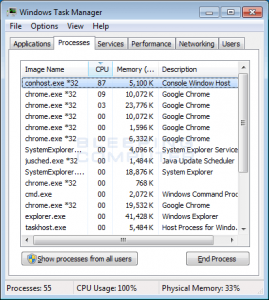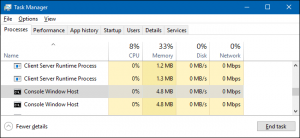How To Remove Conhost.exe From Windows 10 [Fixed]
 conhost.exe (Host Windows Console) is an executable files also known as bitcoin-Miner or DELETE Processes for Windows Services.
conhost.exe (Host Windows Console) is an executable files also known as bitcoin-Miner or DELETE Processes for Windows Services.
It is one of the files belonging to the genuine Windows Operating System. It plays a leading role in running Windows’s important system.
Not all time is set. Unknowingly, your system can be infected with malicious files conhost.exe. Generally, it is located in the system folder, but Betel does not see drive C.
This shows the presence of virus or malicious software fully. However, it only causes irritations on the target system.
Table of Contents
So we suggested looking at removing the effective solution and conhost.exe.
conhost.exe is the malicious files hidden in the system that runs freely. However, this annoying virus does not have a description and is not visible.
This malicious program automatically loaded after Windows start-up, and automatically spread your malicious files. It really is Threats Changes totally unsafe that system function.
conhost.exe usually come in when a system or application has installed programs promoted through third parties, click on advertising links or pop-up, just download attachments that come in the unknown email spam folder, etc.
Their existence only causes discomfort. It tends to assault security settings and granting another threat to enter. In this situation, you need to look for a quick solution to remove conhost.exe.
Conhost.exe is a legitimate file that is used by the Windows operating system to ensure that some specific programs run correctly.
If such conditions happens to your computer, you would immediately notice the issue of system instability, and PC starts to freeze and hang on a regular basis.
This dangerous process elevates other processes to gain administrator rights and they will begin to control the infected PC.
The location for storing changes conhost.exe depending on the version of the operating system used. This file is probably located in both system32 or c: \ winnt \ system32 files.
In some cases, it is stored in the dllcache directory if it is present on your PC. Since the process name looks very genuine, so it can easily disguise itself.
How does the conhost.exe error work?
Conhost.exe infections install your executable on the marked PC in a very secret way.
They copy their loads into the Windows system folders and change the logs simultaneously so that this file runs automatically every time the system boots.
Conhost.exe will modify the subkey named HKEY_LOCAL_MACHINE \ SOFTWARE \ Microsoft \ Windows \ CurrentVersion \ Run to get initialized at PC startup.
Once it is established, it also connects the workstation to a remote host in order to perform unpleasant tasks such as:
- for arbitrary downloads of harmful files in Backdoor
- to receive coded instructions from your developer
- to get the secret configuration
- to transfer cheated data on the infected PC to the remote server
Some common error messages
- “Application error conhost.exe.”
- “Conhost.exe is not a valid Win32 application.”
- “Conhost.exe. This program is not responding.
- “Error starting the program: conhost.exe.”
- “Application path failed: conhost.exe.”
- “Conhost.exe failed.”
How does conhost.exe get inside the PC?
 Cyber criminals use multiple means to circulate conhost.exe on the target PC.
Cyber criminals use multiple means to circulate conhost.exe on the target PC.
It could come through malicious website hyperlinks, grouping, social engineering spam, peer-to-peer file sharing networks, email attachments and so on.
It has the ability to exploit PC security vulnerabilities and be installed secretly without your knowledge. Another easy way is to attach the burden with spam e-mail campaigns, and cyber-criminals do this a lot.
Such spam emails are designed very cunningly with fake header information giving an impression that mail is coming from some governmental organization, shipping company and so on.
Usually these emails have so much grammar and misspellings.
At some point, cyber-criminals also promote conhost.exe as useful software or a necessary Windows system file.
For example, you may notice a fake message asking you to update Java or Adobe Flash Player files, and so on.
Problems and Damage Caused by Conhost.exe
First, understand that conhost.exe is not a stand-alone infection and instead is bound to bring in so many other malware infections by exploiting the security breaches.
Thus, you will face several online as well as offline performance issues simultaneously and commits to the security of personal data as well.
Some of the common problems you may notice are:
- Shows false alerts claiming that your PC is infected with malware
- Prompts victims to click on unpleasant notification hyperlinks to fix problems
- Redirects the website about sponsored dangerous sites
- Blocks access to multiple legitimate programs
- Automatically turns off important processes and records
Most dll files are useful, and they are responsible for smoothly performing predefined functions.
However, there are malicious programs including malware and browser hijackers that are made from dll files such as conhost.exe and alter important PC settings unnecessarily.
They even allow cyber-criminals to gain access to their workstation.
Let’s learn how to remove manually conhost.exe
Methode 1: Remove Conhost.exe from the command prompt window
- Open the command prompt window: Press the “Start” button on the taskbar and go to “Run” to start the “run” tool. Type the “cmd” command on it and press the “OK” button.
- Locate the dll files: Once the command prompt window opens, you have to find the exact path as mentioned in the image below. Type “CD” to change the current directory, press the space button, enter the path of the dlll file and press Enter. Use the “dir” command if you want to display the content on the screen.
- Unregister the unwanted dll: After locating the directory where you want to uninstall the dll, type “regsvr32 / u [DLL_NAME]” and press the Enter button.
- Unsuccessful unsubscription: Once the target dll files get unregistered, a conformation message appears on the screen.
Methode 2: Remove Conhost.exe from the control panel
- Click “Windows key + R key” altogether to open Windows startupimg1
- Type “Control Panel” in the “Startup” window and press the Enter key to open the control panel.img2
- Click on the “Uninstall a program” option.img3
- Select Conhost.exe and right-click to remove it. Similarly, other suspicious programs and files can be excluded in a similar way.img4
Methode 3: Remove Conhost.exe from browsers
- On Chrome: Open Google Chrome> click the Chrome menu> select Tools> click extension> select Conhost.exe extension> recycle binimg5
- On Firefox: Open Firefox> go to the right corner to open the browser menu> select Add-ons> select and remove Conhost.exe extensionsimg6.
- In Internet Explorer: Open IE> click Tools> click on add-on management, tools, and extensions> select the Conhost.exe extensions and its elements and delete them.
Method 4: Remove Conhost.exe malicious files from registry entries
- Open the RUN window by clicking the “window key + R key” altogether.img8
2. Enter the Regedit command and press the Enter key to open the registry.img9
3. Detect registry entries created by Conhost.exe and carefully remove them one by one
- HKLM \ SOFTWARE \ Classes \ AppID \ <random> .exe
- HKEY_CURRENT_USER \ software \ Microsoft \ Internet Explorer \ Main \ Start Page Redirect = ”http: // <random> .com”
- HKEY_LOCAL_MACHINE \ SOFTWARE \ Microsoft \ Windows NT \ CurrentVersion \ virus name
- HKEY_CURRENT_USER \ Software \ Microsoft \ Windows NT \ CurrentVersion \ Winlogon “Shell” = “% AppData% \ <Conhost.exe> .exe”
- HKEY_CURRENT_USER \ Software \ Microsoft \ Windows \ CurrentVersion \ Run
- ‘Random’ HKEY_LOCAL_MACHINE \ Software \ Microsoft \ Windows NT \ CurrentVersion \ Random
The above mentioned manual steps can fix conhost.exe, but there is always a chance that you can not detect it on its own as it is very misleading.
The process is complicated and requires a lot of precision and expertise. So it’s always best to use a powerful anti-malware tool, especially for beginner users.

